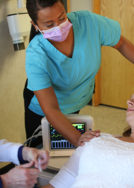Written by Dr. Alice Vessel
Bone, bone, bone… it is the Holy Grail that all dentists are seeking. After all, it is bone that hold the teeth in the jaw.
Periodontal micro-organisms can eat the bone that holds the teeth in. They then become loose and can fall out!
When a tooth is pulled, subsequent healing reduces the volume of bone in the area. The healed ridge appears flat and thin.
And your dentist cries ”IF ONLY THERE WAS MORE BONE…”
TYPES OF BONE GRAFTS
The dental profession has developed materials to increase the volume of bone in the periodontium or to prevent loss of bone around natural teeth or dental implants.
There are different types of grafts:
1. Autograft. This graft takes bone from your own body and transplants it to another place in the body. Thus, there is little chance of rejection or disease transmission. However, it requires a second surgical site and extra cortical bone may be difficult to find.
2. Allograft. This graft uses bone from a donor (cadaver). It is usually a sterilized demineralized freeze-dried material that comes in granules, putties, and blocks depending on the desired area to place the graft. The graft acts as a scaffold where your own bone starts to grow around the material. Bone morphogenic protein in the graft induces bone cells to grow and multiply. This is by far the most used grafting material in dentistry.
3. Xenograft. This graft comes from, well…. *oink, oink*, pigs or oxen. I haven’t used this material, but I have often wondered if patients develop a fondness for, you guessed it, BACON!





